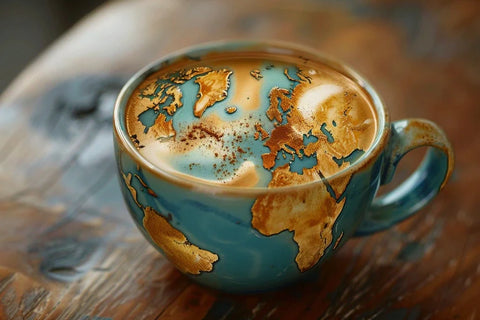What Is Coffee Underwater?
Coffee underwater is a unique process of brewing coffee that involves submerging coffee beans in specially designed containers within the ocean. This innovative method allows the beans to age and infuse with the surrounding seawater, resulting in a distinct flavor profile. High pressure and cool temperatures underwater create a smoother and less acidic taste compared to traditional brewing methods.
Companies like Ocean X and Subaquatic Brew have pioneered this trend, offering coffee enthusiasts an unparalleled experience. The concept of coffee underwater has gained attention for its novelty and potential to revolutionize the coffee industry, providing aficionados with a new sensory experience. However, questions arise about the impact of underwater aging on flavor and the environmental sustainability of such processes.
How Is Coffee Underwater Made?
- To make coffee underwater, use a specially designed pot that can withstand the water pressure at great depths.
- Fill the pot with water and add the coffee grounds.
- Place the pot into a mesh bag to prevent the grounds from floating away.
- Lower the pot to the desired depth and secure it in place.
- Allow the coffee to brew for the required time, considering the pressure and temperature at that depth.
Did you know that the process of making coffee underwater involves special considerations for pressure and temperature, resulting in a unique brewing experience?
What Makes Coffee Underwater Different from Regular Coffee?

Coffee lovers, get ready to dive into the world of underwater brewing. But what makes coffee underwater different from regular coffee? In this section, we'll explore the unique factors that affect the taste and quality of coffee brewed in the deep sea. From the intense pressure and temperature to the extended extraction time, and even the quality of the water, there are many elements that set underwater coffee apart from its land-based counterpart. So, let's take a deep breath and dive into the details.
1. Pressure and Temperature
- Pressure and temperature are essential elements in the preparation of coffee underwater.
- The pressure at greater depths impacts the brewing process, leading to necessary modifications to the brewing equipment to achieve the best extraction.
- Variations in temperature also affect the extraction process, requiring precise control to achieve the desired flavor profile.
- Underwater coffee brewing involves adapting traditional brewing methods to operate effectively in the unique underwater environment.
Read: Perfect Water Temperature For Coffee Brewing
2. Extraction Time
Extraction time is a critical factor in brewing coffee underwater. Here are the essential steps:
- Grinding the coffee to a specific coarseness suitable for underwater brewing.
- Placing the ground coffee into a specially designed filter or brewing apparatus.
- Ensuring the extraction time aligns with the required time for full extraction.
- Filtering the brewed coffee to remove any sediment or particles that may affect the taste.
- Serving the freshly extracted underwater coffee to enjoy its unique characteristics.
In 2018, a team of adventurous divers and coffee enthusiasts ventured into the depths of the ocean to experiment with brewing coffee underwater. This unconventional approach aimed to explore the impact of pressure and temperature on the extraction process, leading to the birth of the extraordinary concept of coffee brewing in the deep sea.
3. Water Quality
When evaluating the water quality for brewing underwater coffee, it is essential to prioritize both purity and neutrality of taste. The water must be free from any contaminants and have a well-balanced mineral content, enhancing the flavor of the coffee without introducing any unwanted elements. The temperature and pressure at the underwater coffee site also have a significant impact on the water quality, influencing the extraction process and overall taste.
By using high-quality filtered or purified water, the distinct brewing environment can positively contribute to the unique characteristics of the coffee.
Read: Bad Brew? Here's A Simple Coffee Troubleshooting Guide
Why Is Coffee Underwater Popular?

Have you ever heard of brewing coffee underwater? It may seem like an unusual concept, but it has been gaining popularity in recent years. So, why is coffee underwater becoming a trend? In this section, we will explore the reasons behind its rise in popularity. From the unique experience it offers to its potential for environmental sustainability, and even the impact on the flavor profile, there are several factors that make coffee underwater a sought-after experience. Let's dive in and find out more.
1. Unique Experience
- Visit an underwater coffee shop to immerse yourself in a truly unique experience. Enjoy the novelty of sipping coffee surrounded by marine life in a one-of-a-kind setting.
- Participate in a diving experience - Coffee Underwater: Brewing in the Deep Sea. Dive into the depths and witness the process of brewing coffee underwater, adding an adventurous touch to your coffee appreciation.
2. Environmental Sustainability
Environmental sustainability is a crucial element of coffee underwater. By utilizing biodegradable materials for coffee capsules and packaging and implementing sustainable farming methods, the environmental impact is minimized. For example, businesses like Ocean Grounds prioritize eco-friendly initiatives by utilizing compostable packaging and supporting projects for marine conservation.
Furthermore, underwater coffee shops often promote ocean preservation and raise awareness about protecting marine life and the environment. As a helpful tip, when sampling coffee underwater, consider supporting brands that prioritize environmental sustainability, helping to preserve marine ecosystems while experiencing a one-of-a-kind coffee experience.
Read: Eco-Friendly Coffee Habits How to Enjoy Your Brew Sustainably
3. Flavor Profile
When discussing the flavor profile of underwater coffee, several factors come into play, resulting in a unique sensory experience:
- Water pressure: Underwater brewing exposes coffee to higher pressure, enhancing the extraction of flavors and oils from the beans.
- Temperature: The consistent cool temperature of the ocean's depths affects the extraction process, potentially leading to a smoother, less acidic taste profile.
- Hydrostatic pressure: This mechanical pressure can compress the gases in the coffee, influencing the aroma and overall flavor intensity.
What Are the Potential Risks of Coffee Underwater?

As exciting as the concept of brewing coffee underwater may be, there are also potential risks that come with this unconventional method. In this section, we will discuss the three main risks associated with coffee brewing in the deep sea: oxygen deprivation, pressure-related injuries, and contamination. By understanding these risks, we can weigh the potential dangers against the thrill of a unique coffee experience.
1. Oxygen Deprivation
- Understand the Risks: Be aware of the potential risks associated with oxygen deprivation when attempting to brew or consume coffee underwater.
- Seek Professional Guidance: Consult with experts in diving and marine safety to mitigate the risks of oxygen deprivation when trying coffee underwater.
- Use Proper Equipment: Ensure that appropriate breathing apparatus and safety measures are in place to prevent oxygen deprivation during the underwater coffee experience.
In the 17th century, a group of adventurous seafarers attempted to enjoy their morning coffee at the bottom of the ocean. Despite facing the challenges of oxygen deprivation, they successfully brewed and savored their underwater coffee, marking a remarkable chapter in the history of coffee exploration.
2. Pressure-related Injuries
When considering pressure-related injuries in the context of underwater coffee, it is important to acknowledge the potential risks that come with increased pressure at depth. Divers or individuals involved in deep-sea coffee brewing may experience barotrauma, which can affect the ears, sinuses, and lungs due to the compression of air spaces. In addition, divers must follow strict decompression guidelines to reduce the risk of decompression sickness, also known as 'the bends.'
Proper training, equipment, and adherence to safety protocols are essential in preventing pressure-related injuries during underwater coffee experiences. Prioritizing safety and adhering to established diving procedures will help decrease the chances of pressure-related injuries, ensuring a safe and enjoyable underwater coffee experience.
3. Contamination
- To minimize the risk of contamination, it is important to use high-quality, purified water.
- Regularly cleaning and sanitizing all brewing equipment is essential in preventing bacterial growth or impurities.
- Coffee bean storage containers should be kept in a clean, dry environment and sealed tightly to avoid potential contamination.
- Inspecting and maintaining the brewing area and equipment regularly can prevent mold, mildew, or other contaminants from affecting the brewing process.
When brewing coffee, it is crucial to ensure purity and cleanliness underwater to avoid any potential health risks. By following these steps, a contamination-free environment can be maintained, ensuring a safe and enjoyable coffee experience.
How Can One Try Coffee Underwater?

Have you ever wondered what it would be like to enjoy a cup of coffee in the depths of the ocean? While it may seem like an impossible feat, there are actually ways to experience this unique and exhilarating activity. In this section, we will discuss two ways that you can try coffee underwater. We’ll take a closer look at visiting an underwater coffee shop, as well as participating in a diving experience that offers the opportunity to brew and enjoy coffee in the deep sea.
1. Visiting an Underwater Coffee Shop
- Research the location of underwater coffee shops, such as those in the Maldives or Dubai.
- Plan the visit based on the coffee shop's operating hours and availability of underwater seating.
- Book a guided underwater coffee experience, ensuring necessary diving or snorkeling certifications are in place.
- Arrive at the designated meeting point and follow all safety instructions provided by the coffee shop's staff.
- Enjoy the unique experience of sipping coffee amidst the marine life and underwater surroundings.
In 2018, the world's first permanent underwater coffee shop, Sea of Coffee, was opened in the Maldives, allowing visitors to experience the thrill of visiting an underwater coffee shop while surrounded by the beauty of the Indian Ocean.
2. Participating in a Diving Experience
- Find a reputable diving company or underwater coffee shop offering the experience.
- Ensure you meet the necessary diving requirements and certifications.
- Book the diving experience in advance to secure your spot and prepare accordingly.
- Attend a briefing to understand safety protocols, equipment usage, and the overall experience.
- Participate in the unique coffee brewing process while undergoing the diving experience, following all instructions.
In 2018, a company in South Korea introduced the world's first underwater coffee shop, allowing customers to participate in a diving experience and enjoy coffee brewed 130 feet below the sea. This innovative concept combined adventure, novelty, and the love for coffee, creating an unforgettable experience for both diving enthusiasts and coffee aficionados.


